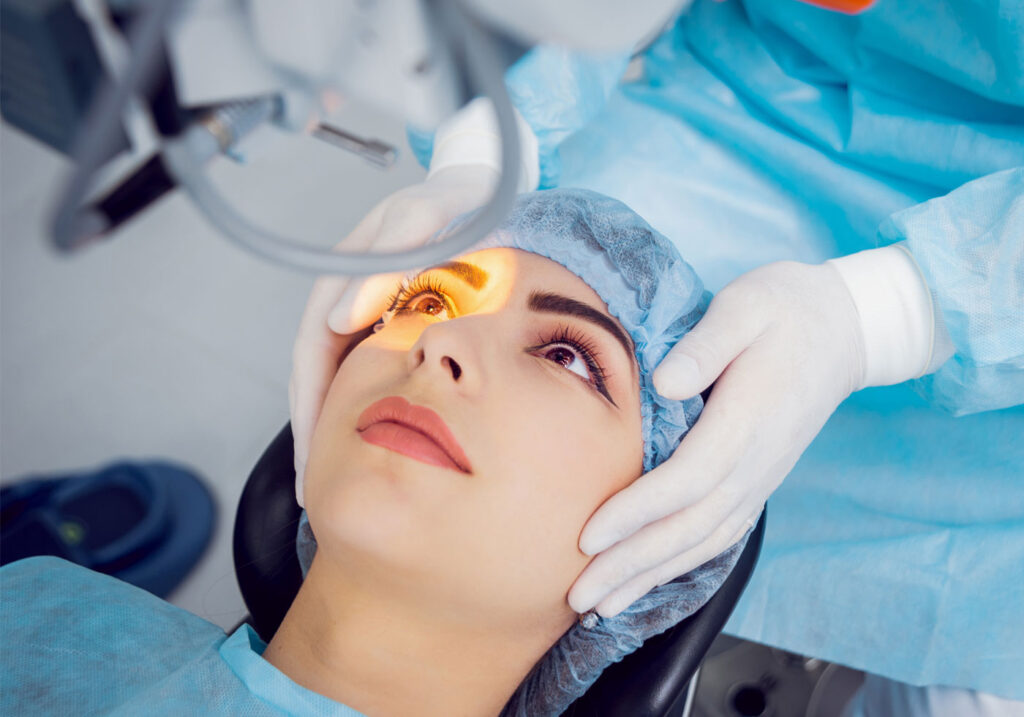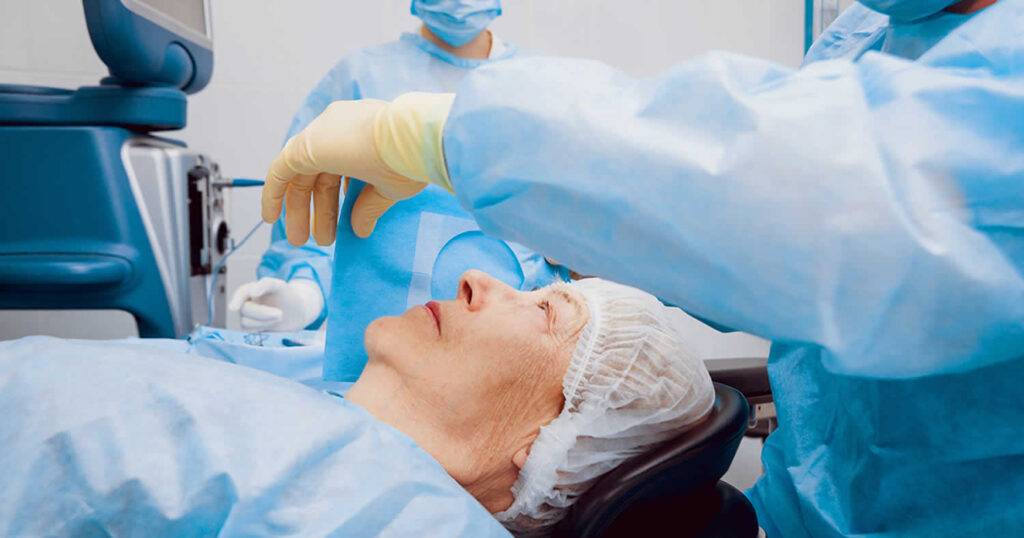Beyond Blurriness: The Transformative Power of Cataract Surgery

Cataracts can have a significant impact on one’s quality of life, causing blurred vision and difficulty performing everyday activities. Fortunately, cataract surgery offers a transformative solution that can restore clear vision and improve overall well-being.
In this article, we will delve into the intricacies of cataracts, the advancements in cataracts surgery, and the life-changing effects it can have for individuals.
Understanding Cataracts: A Brief Overview
Cataracts refer to the clouding of the lens of the eye, which leads to blurred or hazy vision. They typically develop slowly and gradually worsen over time. As the lens becomes clouded, it interferes with the passage of light through the eye, resulting in vision impairment. Cataracts commonly occur due to age-related changes in the proteins of the lens, but they can also be caused by factors such as genetics, diabetes, smoking, and prolonged exposure to sunlight.
What are Cataracts?
Cataracts are a progressive condition that affects the lens of the eye. The lens is normally clear and plays a crucial role in focusing light onto the retina, allowing us to see clearly. However, as cataracts develop, the lens becomes cloudy, reducing the amount of light that reaches the retina. This causes blurry vision, difficulty seeing at night, and increased sensitivity to glare.
In addition to these common symptoms, cataracts can also cause a range of other visual disturbances. Some individuals may experience double vision in one eye, while others may notice a yellowish or brownish tint to their vision. These variations in symptoms can depend on the location and severity of the cataract.

It is important to note that cataracts do not cause pain or discomfort in the eye itself. However, the impact on vision can significantly affect daily activities, such as reading, driving, and recognizing faces. This can have a profound impact on an individual’s overall quality of life.
Causes and Risk Factors of Cataracts
While aging is the most common cause of cataracts, other risk factors can contribute to their development. These include genetic predisposition, certain medical conditions such as diabetes, prolonged use of corticosteroid medications, smoking, excessive alcohol consumption, and prolonged exposure to ultraviolet (UV) radiation from the sun.
Genetics can play a role in the development of cataracts, as certain inherited conditions can increase the likelihood of developing the condition at an earlier age. Additionally, individuals with diabetes are at a higher risk of developing cataracts due to the impact of high blood sugar levels on the lens of the eye.
Smoking has also been identified as a risk factor for cataracts. The chemicals present in tobacco smoke can accelerate the clouding of the lens and increase the progression of cataracts. Similarly, excessive alcohol consumption can contribute to the development of cataracts by causing oxidative stress and damage to the lens.
Prolonged exposure to UV radiation from the sun is another significant risk factor for cataracts. The lens of the eye acts as a natural filter for UV rays, but over time, the cumulative exposure can lead to the formation of cataracts. It is crucial to protect the eyes by wearing sunglasses with UV protection and a wide-brimmed hat when spending time outdoors.
It’s essential to be aware of these risk factors to take preventative measures and seek timely treatment if cataracts begin to impact daily life significantly. Regular eye examinations and maintaining a healthy lifestyle can help reduce the risk of developing cataracts and ensure early detection and appropriate management if they do occur.
The Science Behind Cataract Surgery
Cataract surgery is a highly effective and safe procedure that involves removing the clouded lens and replacing it with a clear artificial lens, known as an intraocular lens (IOL). This surgical intervention allows light to pass through the eye unimpeded, restoring clear vision.
When a cataract forms, the lens of the eye becomes cloudy, leading to blurry or hazy vision. This cloudiness is caused by the clumping of proteins within the lens, which prevents light from properly reaching the retina at the back of the eye. Cataracts can develop due to various factors, including age, genetics, and certain medical conditions.
The Procedure: What to Expect
Cataract surgery is typically performed as an outpatient procedure under local anesthesia. The surgeon makes a small incision in the cornea, the clear front surface of the eye, and uses ultrasound energy to break up the cloudy lens into small pieces, which are then removed. This technique is known as phacoemulsification.
After the cloudy lens is removed, the surgeon carefully inserts the IOL through the same incision and positions it in the lens capsule, a thin membrane that holds the natural lens in place. The IOL is designed to mimic the focusing ability of the natural lens, allowing for clear vision at various distances.
This procedure is relatively quick, usually lasting around 20-30 minutes. Many individuals experience improved vision immediately after surgery, with the full effects typically realized within a few weeks. It is important to follow post-operative instructions provided by the surgeon to ensure proper healing and minimize the risk of complications.

Technological Advances in Cataract Surgery
Advancements in technology have revolutionized cataract surgery, making it safer and more accurate than ever before. One such advancement is the use of femtosecond lasers, which offer precise incisions and fragmentation of the lens. These lasers use ultra-short pulses of light to create incisions with remarkable precision, resulting in improved surgical outcomes.
In addition to laser technology, the development of premium IOLs has significantly enhanced the visual outcomes of cataract surgery. Traditional IOLs provide clear vision at a fixed focal point, usually for distance vision. However, premium IOLs offer enhanced customization to address specific vision concerns. For example, toric IOLs can correct astigmatism, while multifocal or extended depth of focus IOLs can provide clear vision at multiple distances.
With the use of advanced diagnostic tools and measurements, surgeons can now accurately determine the most suitable IOL power and type for each individual patient. This personalized approach allows for better visual outcomes and increased patient satisfaction.
These technological advances have contributed to better visual outcomes and increased patient satisfaction, showcasing the continuous improvement in cataract surgery techniques. As technology continues to evolve, the future of cataract surgery holds even more promise for improved patient experiences and outcomes.
The Transformative Power: Life Before and After Cataract Surgery
Cataract surgery goes beyond merely restoring clear vision; it has the power to transform lives in numerous ways. Let’s explore some of the significant benefits experienced by individuals who undergo this life-changing procedure.
Imagine waking up every day to a world shrouded in a blurry haze, colors muted and details obscured. This is the reality for those living with cataracts, a condition that clouds the lens of the eye and impairs vision. However, with advancements in medical technology, cataract surgery offers a beacon of hope, a chance to regain not only clear vision but also a new lease on life.
The Impact on Vision Quality
With cataracts removed and clear IOLs (Intraocular Lenses) implanted, individuals often experience a remarkable improvement in vision quality. Colors become more vibrant, contrast is enhanced, and overall visual acuity is restored. The world transforms from a blurry painting to a high-definition masterpiece.
Imagine strolling through a garden, where every flower petal is vividly defined, every shade of green in the leaves pops with vibrancy. Or imagine sitting by the ocean, watching the waves crash against the shore, with each droplet sparkling in crystal clarity. These are the moments that cataract surgery can bring back to life.
Not only does improved vision quality allow for a clearer perception of the world, but it also enables individuals to engage in daily activities with ease and confidence. Reading becomes a pleasure once again, as words on a page regain their sharpness. Driving becomes safer, as road signs and traffic lights are no longer obscured. And hobbies such as painting or knitting can be pursued with renewed passion, as the intricate details can be appreciated once more.
Emotional and Psychological Benefits
Living with cataracts can be emotionally challenging, as vision deterioration can lead to feelings of frustration, isolation, and a loss of independence. Simple tasks like recognizing faces or navigating unfamiliar places become daunting obstacles. However, after cataract surgery, individuals often report a significant boost in emotional well-being.
Imagine the joy of being able to recognize the faces of loved ones, to see the expressions of happiness or concern that were once hidden in a blur. The restoration of clear vision instills a renewed sense of self-confidence, improved social interactions, and a rekindled zest for life.
No longer held back by the limitations of impaired vision, individuals can once again participate in activities they once enjoyed. Whether it’s joining a dance class, exploring the great outdoors, or simply going for a walk in the park, the world becomes a playground of possibilities.
Furthermore, the psychological impact of cataract surgery extends beyond the individual. Family members and friends witness the transformation, rejoicing in the newfound happiness and vitality of their loved ones. It becomes a shared celebration, a reminder of the power of modern medicine to restore not just physical health but also emotional well-being.
In conclusion, cataract surgery is not just a medical procedure; it is a gateway to a world of clarity, color, and renewed joy. It has the power to transform lives, allowing individuals to see the world in all its vibrant glory and embrace a future filled with limitless possibilities.

Debunking Myths: Common Misconceptions about Cataract Surgery
Despite its widespread success, there are still myths and misconceptions surrounding cataract surgery that may deter individuals from seeking treatment. Let’s address some of the common concerns and debunk these misconceptions.
Is Cataract Surgery Painful?
One of the most prevalent myths surrounding cataract surgery is that it is a painful procedure. However, this couldn’t be further from the truth. Thanks to anesthesia and modern surgical techniques, cataract surgery is virtually painless. Most individuals report minimal discomfort during the procedure, and any post-operative discomfort is typically well-managed with prescribed medication.
The Risks and Complications: How Common Are They?
Another misconception is that cataract surgery carries significant risks and complications. While no surgical procedure is entirely risk-free, cataract surgery has an admirable safety profile. Serious complications are rare, with the majority of procedures resulting in successful outcomes.
Making the Decision: Factors to Consider Before Undergoing Surgery
Deciding to undergo cataract surgery is a personal choice that should be considered carefully. Several factors can influence this decision, including the extent of vision impairment, the impact on daily activities, and the individual’s overall health and lifestyle.
When is the Right Time for Surgery?
Determining the right time for cataract surgery involves assessing how severely the cataracts are affecting vision and quality of life. If the blurred vision significantly hampers daily activities such as reading, driving, or engaging in hobbies, it may be time to explore the option of surgery. Consulting with a trusted ophthalmologist can provide valuable insights and guidance tailored to individual circumstances.
Choosing the Right Surgeon and Clinic
Choosing a skilled and experienced surgeon is crucial for a successful cataract surgery outcome. Researching and selecting a reputable clinic that specializes in cataract surgery is paramount. Seek recommendations, read patient reviews, and schedule consultations with potential surgeons to ensure you are comfortable with their expertise and approach.
In conclusion, cataract surgery offers a life-altering solution for individuals struggling with vision impairment caused by cataracts. With advancements in technology and surgical techniques, this procedure has become safer, more precise, and more customizable than ever before. The transformative power of cataract surgery goes beyond restoring clear vision, bringing emotional well-being, improved quality of life, and renewed independence to those who undergo it. By debunking common misconceptions and considering relevant factors, individuals can make informed decisions about their vision health and explore the amazing possibilities that lie beyond blurriness.
More to read: Your Guide to Effective Sleep Therapy
